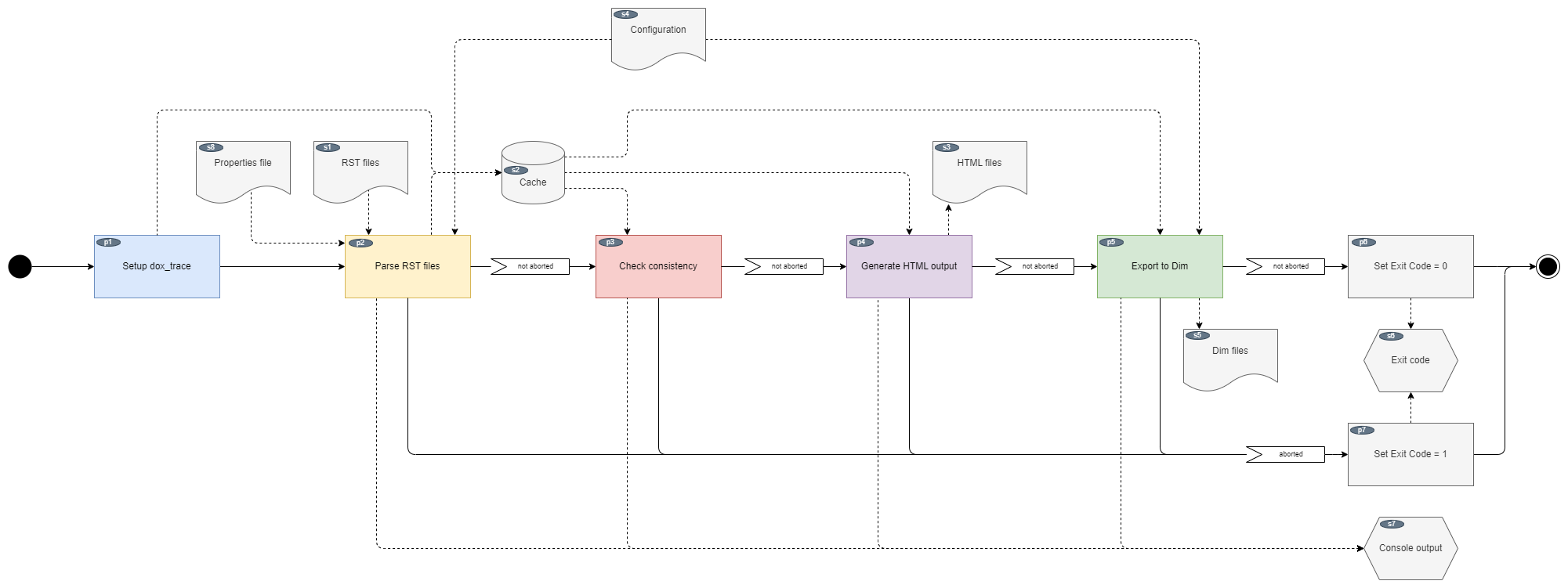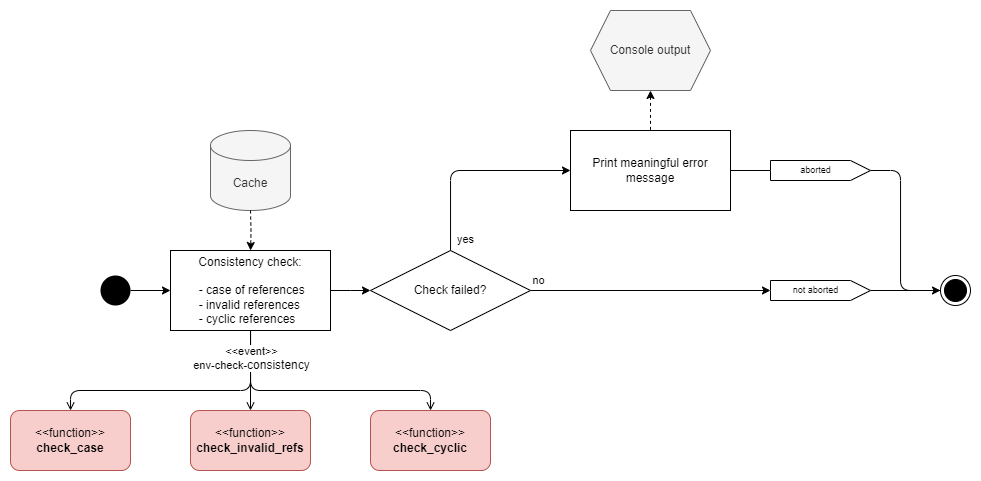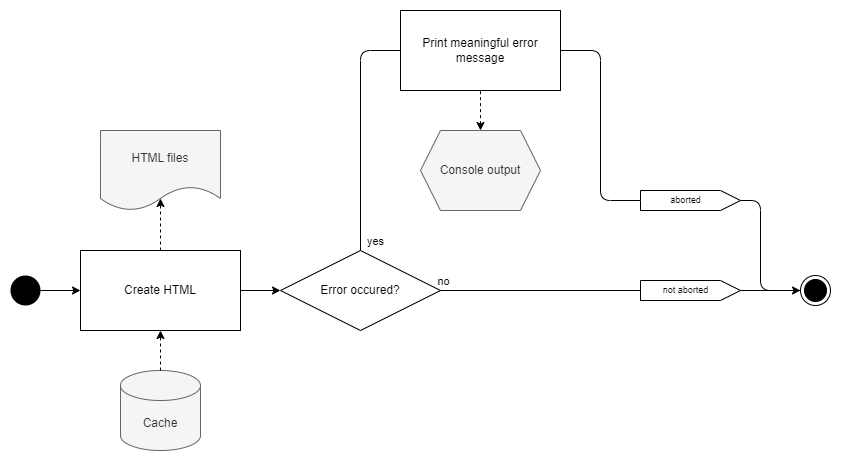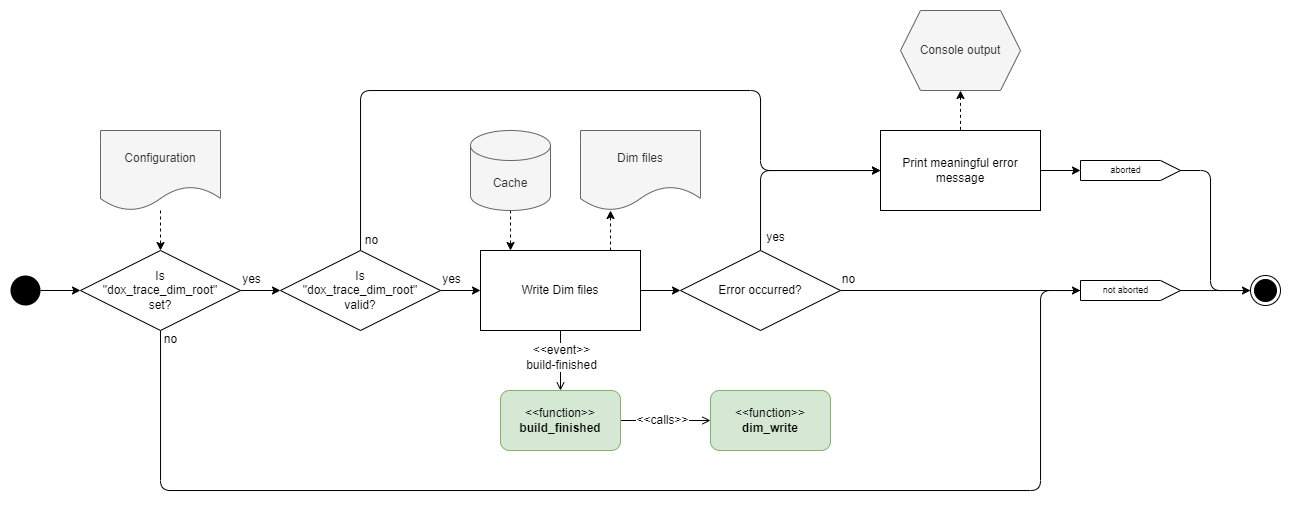Dynamic Behaviour
Main Workflow
The main workflow is a sequence of five major steps which are explained in more detail in the sections below.

Fig. 7 Main workflow
All input and output is directly accessed by the user of this tool except the cache. The cache is created by Sphinx to increase the speed of incremental builds. Files which have not changed since the last build usually don’t have to be read again. dox_trace enriches the cache with specification data to resolve references, perform consistency checks and export data to Dim.
In general, exceptions are not caught. If an exceptions occurs, Sphinx terminates and sets the exit code to a value != 0 depending on the exception type.
Setup dox_trace

Fig. 8 Setup dox_trace
Setting up dox_trace is straightforward:
First, the source files are loaded by the Python interpreter.
Afterwards Sphinx calls the setup function which is mandatory for every extension. This function registers callbacks to certain Sphinx events, directives and roles.
The first event is config-inited which allows to add additional stuff to the Sphinx configuration. dox_trace registers a CSS and a Javascript file for the HTML output.
If the dox_trace extension itself has changed, it is not ensured that the data in the cache is still compatible, so dox_trace enforces a reload of all RST files.
The cache, internally also called environment, is getting prepared by creating some data structures which are used later by dox_trace.
Data from RST files which are going to be read again is deleted from the cache.
Parse RST Files

Fig. 9 Parse RST files
After the environment is prepared in Setup dox_trace, the new and changed RST files can be read:
Sphinx calls the registered classes and functions for the following elements found in RST files:
most importantly the specification directives:
.. requirement::.. information::.. srs::.. spec::.. mod::.. interface::.. unit::
the
.. dox_trace_config::directive which generates a page to configure the appearance of the specificationsthe
.. traceability_report::directive which generates a traceability reportthe
.. unresolved_refs::directive which generates a list of specifications with unresolved referencesthe
.. prop::directive and:prop:role which display a propertyinternally used roles to create nice literals in HTML output with type and ID of specifications which can be linked by regular Sphinx references.
These functions convert the data to “Docutils” nodes, the underlying document structure used by Sphinx.
The Sphinx syntax for directives is very close to the comment syntax, which means a specification may be commented out unintentionally. To avoid that, a check is implemented to find comments which look similar to a specification directive.
After all files are parsed, upstream and downstream references can be calculated. They are injected into the already created “Docutils” node structure.
Finally the data is stored in the cache.
In parallel (multi-threaded) builds a separate cache section is created by Sphinx for every parsed RST files to avoid critical sections. After reading all files, these sections must be merged.
If an error occurs, a meaningful error message is printed out and the build is aborted.
Check Consistency

Fig. 10 Check consistency
After all data is loaded, the following checks are performed:
References in Sphinx are internally converted to lower case, which means the references are case insensitive. But when exporting to Dim, the case matters, so dox_trace ensures that the case is always correct.
Specifications can link to other specifications using their
refsattribute. dox_trace ensures that the targets are really specifications and not regular Sphinx anchors.Cyclic references are disallowed to avoid problems in further processing of the data like generating metrics.
If a check fails, a meaningful error message is printed out and the build is aborted.
Generate HTML Output

Fig. 11 Generate HTML output
This step is completely done by Sphinx, the dox_trace extension is not involved directly. In case of an error, Sphinx prints an error message and aborts the build.
Export to Dim

Fig. 12 Export to Dim
If the Sphinx configuration includes a variable dox_trace_dim_root pointing to a valid
directory, dox_trace exports the specification data of srs, spec, mod, interface and unit to
Dim files. If an error occurs, a meaningful error message is printed out and the build is aborted.